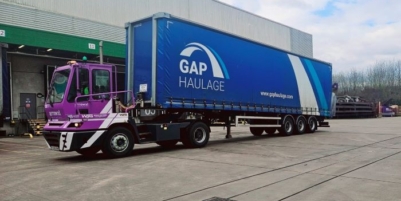-
Nutrivend selects Forterro’s Orderwise to support online expansion and streamline operations - April 11, 2025
-
ARROWXL LAUNCHES AMBITIOUS ZERO WASTE ROADMAP - April 8, 2025
-
THE BCMPA’S NEW CAMPAIGN DRIVES OUTSOURCING SUCCESS IN Q1 - April 7, 2025
-
BLACKOUT TECHNOLOGIES TARGETS TELEMATICS-INTEGRATED MOBILE DEVICE BLOCKING TO COMBAT SMARTPHONE DISTRACTION - April 1, 2025
-
Sparck Technologies awarded Royal designation - March 27, 2025
-
OpenADR Alliance announces first OpenADR 3.0 certified products with EVoke Systems, E.ON Energy and Universal Devices - March 25, 2025
-
Growing fulfilment and contract packer appoints new Managing Director - March 25, 2025
-
When is it time to invest in a WMS? Understanding the key trigger points - March 25, 2025
-
eCapital helps Vantage Recruitment on its journey to financial success - March 24, 2025
-
Hugo Beck Celebrates 70 Years of Packaging Innovation with Open House Events - March 20, 2025
Investing in a Warehouse Management System (WMS) is a big decision for any company, but when the organisation in question is a SME and transitioning from a paper-based system, it can be especially daunting. One very important consideration is finding a WMS that can scale easily as your company grows. Eric Carter, Solutions Architect at Indigo Software shares six essential tips to help you choose the best WMS for your current and future business needs.
Flexible integration capabilities
A high percentage of manufacturing businesses will be using an Enterprise Resource Planning (ERP) system, even if they are relying on paper in the warehouse. If you are investing in a WMS to enhance efficiency, ensure that the solutions you are considering will seamlessly integrate with your existing ERP system. This integration is crucial for automating data input and enhancing prediction and management capabilities. Rather than having information in silos, it means the two systems will be able to exchange data in real-time, giving you a single, accurate view of the entire logistic business operation.
In addition to the ERP system, the WMS you choose needs to integrate with financial accounting systems and Transportation Management Systems (TMS), to provide end to end operational support. Indigo Software has performed many successful integrations with leading ERP systems and other solutions that require an interface to logistics and warehousing information. Indigo WMS can integrate with Infor, Sage, Oracle, SAP, plus TMS solutions and other materials handling equipment, including racking and carousel systems.
Easy to use and intuitive interface
Introducing a WMS into a warehouse can represent a big change to working patterns for operatives who would previously have used paper pick sheets and reports. Finding a system with an intuitive and simple interface makes the transition easier and reduces the need for extensive training, allowing your team to focus on making warehouse operations more efficient. Indigo WMS has a built-in business intelligence tool with graphical reporting, so anyone can see immediately what the status of the day’s order pool is and where additional resources may be required to meet throughput targets.
Real-time updates and visibility
The single biggest business improvement realised by implementing a WMS is the arrival of real-time updates. In a fast-moving, rapidly growing business, this is essential for maintaining an efficient, customer centric operation. For instance, a WMS provides real-time visibility into inventory levels and makes it possible to introduce perpetual inventory management. This type of stock management process eliminates the need for separate stock counts because stock is being counted automatically as part of routine warehouse operations. In addition to minimising shrinkage, because stock is always accounted for in real-time, it also means that stock replenishment processes can be synchronised with the picking cycle. This further improves efficiency and productivity, because operatives are never waiting for items in a pick schedule to be replenished for example.
Support for multiple warehouses and 3PL services
Many companies will start with a single warehouse implementation when they first introduce a WMS and then, once the system is fully operational, they will extend the software to be used across multiple, integrated sites. Other companies might only have one warehouse to begin with but as they scale the business, will add more sites. If you anticipate expanding to multiple locations, ensure the WMS can manage inventory and orders across different sites seamlessly.
These are two very common scenarios and so it is essential to choose a WMS that can support multiple warehouses and handle increased order volumes and many different types of order profile as the business expands. This ensures that the system can grow alongside your company and has the flexibility to adapt to whatever direction the business takes. Given the high cost of warehousing, some businesses with spare capacity are starting to offer 3PL services to other local businesses seeking a flexible logistics partner.
Vendor reputation for customer service and industry knowledge
Investing in a WMS is a long-term decision and it is important to thoroughly research potential vendors to ensure they have an outstanding track record of system reliability and customer support. A best of breed vendor will have a clear software roadmap they will be willing to share, showing how the solution is being enhanced by incorporating existing user feedback and by offering regular system updates and security improvements. Overall, by selecting a WMS with a history of growth and innovation, you will ensure it remains relevant and effective for your business as it continues to evolve.
Clear cost analysis and ROI projection
When migrating from a paper-based system, the return on investment (ROI) to be gained from adopting a software-based WMS is very strong. Warehouse management will need to evaluate the savings achievable through reduced errors and increased operational efficiency to justify the initial cost outlay. Once this is calculated, the financial returns will be evident almost from day one and as the warehouse becomes more efficient, these cost benefits will continue to be delivered, day after day and year after year.
When obtaining the initial business approval for a new WMS, budget considerations will need to include the upfront software and hardware expenditure, ongoing system maintenance costs and initial training expenses. Depending on the type of system you select, it may be possible to implement a new WMS on existing hardware.
By considering all these factors carefully, a company looking to implement a new WMS can ensure that they select a solution that can grow with the business – one that not only meets current needs but has the flexibility to support future growth and operational excellence.
Author: Eric Carter, Solutions Architect at Indigo Software
































